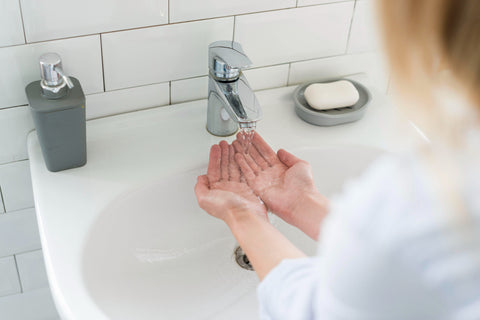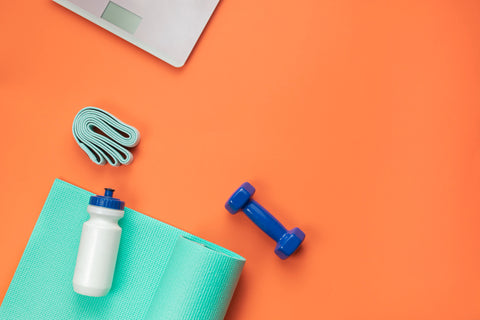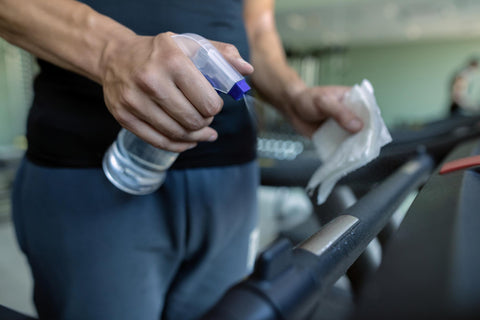
Skin Infection From The Gym: How to Prevent
Skin infections are a common concern for individuals who frequent gyms and fitness centers. The warm, moist environments of gyms, combined with shared equipment and close contact activities, create a breeding ground for various pathogens. It's crucial for gym-goers to be aware of the prevalence and risks associated with skin infections from gym environments. Understanding and preventing these infections is not just about personal health; it's about safeguarding the health of the entire gym community.
The Importance of Prevention

Preventing skin infections from the gym is essential for several reasons. First, it ensures that individuals can continue their fitness routines without interruption. Skin infections can lead to discomfort, pain, and even the necessity to pause one's workout regimen. Secondly, by preventing these infections, individuals contribute to a cleaner, healthier gym environment for everyone. Awareness and preventive measures can significantly reduce the spread of infectious agents, making the gym a safer place for all.
Understanding Skin Infections
Skin infections are caused by various pathogens, including bacteria, fungi, and viruses, each capable of thriving in the gym environment. These infections can range from mild irritations to severe health issues requiring medical attention. Here's a closer look at the types of skin infections commonly linked to gym settings:
- Athlete's Foot (Fungal): Athlete's foot, a fungal infection that thrives in warm, damp areas, making the gym locker room floors a common site for transmission.
- Ringworm (Fungal): Ringworm, another fungal infection that can spread through direct contact with infected surfaces, including gym mats and equipment.
- Staphylococcus Aureus Infections, Including MRSA (Bacterial): MRSA, These bacteria can live on the skin without causing issues until they enter the body through cuts or abrasions, common among gym-goers.
- Herpes Simplex Virus (Viral): While typically known for causing cold sores, the herpes virus can also lead to infections on other parts of the body through shared gym equipment and close physical contact sports.
The Role of the Gym Environment in Infection Spread
The gym environment facilitates the spread of these infections in several ways. High-touch surfaces such as weights, machines, and mats harbor pathogens that transfer onto the skin. The humid atmosphere of locker rooms and showers provides an ideal environment for fungi to proliferate. Moreover, the communal nature of gyms, where people work out closely and share amenities, increases the likelihood of cross-contamination. Understanding these risk factors is the first step in adopting effective prevention strategies to combat skin infection from gym exposure.
III. Factors Contributing to Skin Infections in Gyms
Understanding the factors contributing to the spread of skin infections from gym environments is crucial for prevention. Gyms, by their very nature, are communal spaces where individuals come to improve their physical health, but these shared environments can also harbor risks if not properly managed.
Shared Equipment and Surfaces
One of the primary contributors to the transmission of pathogens that lead to skin infections in gyms is the use of shared equipment and surfaces. Equipment like weights, treadmills, exercise bikes, and mats are touched by numerous individuals throughout the day. Without proper cleaning and disinfection between uses, these surfaces can retain bacteria, fungi, and viruses, acting as a vector for skin infection transmission. The role of shared equipment in spreading infection underscores the importance of rigorous cleaning protocols by gym management and responsible usage by gym-goers.
Personal Hygiene and Sweat
Personal hygiene plays a pivotal role in preventing skin infections from the gym. Sweat, produced during exercise, not only contributes to a moist environment conducive to pathogen growth but can also strip the skin of its protective oils, making it more susceptible to infection. When sweat is left to dry on the skin, it can create an ideal situation for bacteria and fungi to thrive. Regularly showering before and after using the gym, using antimicrobial soap, and ensuring hands are washed frequently can significantly reduce the risk of skin infection.
Minor Cuts and Abrasions
The risk of skin infection from gym exposure is markedly increased by the presence of minor cuts and abrasions. These small wounds can serve as entry points for pathogens, bypassing the body's primary defense mechanism—the skin barrier. Activities that lead to scrapes or breaks in the skin, whether from using equipment or engaging in physical activities, can inadvertently facilitate the entry of harmful microbes. It's essential for individuals to cover any cuts or abrasions with waterproof bandages before entering communal gym spaces and to treat any injuries promptly and appropriately to prevent infection.
Preventative Measures
Acknowledging these factors is the first step in implementing effective strategies to combat the risk of skin infection from gym use. By focusing on cleanliness, personal hygiene, and the careful management of minor injuries, both gym operators and patrons can work together to create a safer and healthier environment for everyone involved. This collaborative effort not only enhances individual health outcomes but also contributes to the overall wellness of the community.
IV. Prevention Strategies for Skin Infection from Gym

Preventing skin infections acquired from gym facilities is paramount for maintaining overall health and ensuring that fitness routines remain beneficial rather than harmful. Here are comprehensive strategies focused on personal hygiene and protective measures that can significantly reduce the risk of infection.
A. Personal Hygiene
- Washing Hands and Showering: One of the most effective ways to prevent skin infection from gym activities is by emphasizing the importance of washing hands and showering both before and after workouts. This practice helps remove bacteria, viruses, and fungi that might have been picked up from shared surfaces or equipment.
- Using Skin Disinfectant Products: Incorporating skin disinfectant products, such as MatGuard's antibacterial body wipes, into your gym routine can offer an additional layer of protection against pathogens. These wipes are designed to kill germs on the skin's surface, reducing the risk of skin infection.
- Antimicrobial Soap: The selection of antimicrobial soap for showering post-workout is crucial. These soaps kill or inhibit the growth of bacteria, providing a more effective cleanse than regular soap.
- Thorough Drying: After showering or washing, thorough drying is essential. Moist environments promote the growth of fungi and bacteria, so keeping the skin dry, especially in areas prone to sweat accumulation, is vital.
- MatGuard's Surface Sprays and Wipes: For an added layer of protection, we recommend using MatGuard's surface sprays and surface wipes on all gym equipment before and after use. These products disinfect surfaces, significantly reducing the risk of skin infection from gym equipment.
B. Protective Measures
- Wearing Flip-Flops: In gym showers and locker rooms, wearing flip-flops can prevent direct contact with the floor, where fungi like those causing athlete's foot thrive. This simple measure can greatly reduce the risk of fungal infections.
- Barrier Protection: Utilize barrier protection such as gloves and towels on shared equipment to prevent direct skin contact with surfaces that may be contaminated with pathogens. This practice is particularly important for preventing the transmission of bacteria and viruses.
- Moisture-Wicking Fabrics: Choosing moisture-wicking fabrics for workout attire can help keep the skin dry and less hospitable to the growth of bacteria and fungi. These fabrics draw sweat away from the body, reducing the risk of skin infections that thrive in moist environments.
Implementing these prevention strategies can significantly reduce the risk of acquiring skin infections from gym settings. By prioritizing personal hygiene and adopting protective measures, gym-goers can enjoy a healthier and safer workout environment.
IV. Prevention Strategies for Skin Infection from Gym
C. Equipment and Facility Care

One of the most effective strategies to prevent skin infection from gym use involves diligent care and maintenance of equipment and facilities. Encouraging gym-goers to wipe down gym equipment before and after use with a surface wipe can significantly reduce the risk of pathogen transmission. Matguards surface sprays, specifically designed for the fitness industry, offer a potent formula that tackles germs effectively while being gentle on both skin and equipment. By making disinfecting wipes and sprays readily available, gyms can foster a culture of cleanliness and responsibility among members.
Selecting gyms that maintain high cleanliness and sanitation standards is equally important. When choosing a gym, consider facilities that demonstrate a clear commitment to hygiene, with visible cleaning schedules, ample disinfectant stations, and staff actively engaged in cleaning efforts. A gym's dedication to maintaining a clean environment is a critical factor in minimizing the risk of skin infections and ensuring a safe workout space for everyone.
D. Health Practices
Adopting responsible health practices is key to preventing skin infection from gym environments. Keeping personal items personal, such as towels, water bottles, and razors, is essential to avoid cross-contamination. Sharing these items can easily transfer pathogens from one person to another, increasing the risk of skin infections.
Before engaging in gym activities, it's advisable to cover any cuts or abrasions with waterproof bandages. This simple yet effective measure provides a barrier against bacteria and fungi, preventing them from entering the body through breaks in the skin. Ensuring that any minor injuries are properly protected before a gym session can significantly reduce the likelihood of acquiring a skin infection from gym facilities.
Emphasizing Prevention
By implementing these prevention strategies, individuals can significantly reduce their risk of skin infection from gym use. Encouraging personal hygiene, advocating for the proper care of equipment and facilities, and practicing good health habits are all crucial steps in creating a safer gym environment. Through collective efforts and awareness, the fitness community can enjoy the benefits of physical exercise while minimizing the risk of skin infections.
V. Recognizing and Responding to Skin Infections
Recognizing the early signs of skin infections is crucial for anyone regularly using gym facilities. Early symptoms can include redness, swelling, itching, pain, or the appearance of blisters and sores. These signs can vary depending on the type of infection—fungal, bacterial, or viral. For gym-goers, paying close attention to any unusual skin changes, especially in areas that come into contact with gym equipment or surfaces, is important for early detection.
Stressing the importance of seeking medical advice for suspicious symptoms cannot be overstated. If you notice any signs of a skin infection, consulting with a healthcare provider promptly ensures accurate diagnosis and treatment. Early medical intervention can prevent the infection from worsening or spreading to others.
The potential consequences of untreated skin infections can be severe, ranging from the spread of the infection to other body parts to entering the bloodstream and causing more systemic issues. Certain infections, if left unchecked, can lead to long-term skin damage or more serious health complications. It's vital for individuals to understand these risks and respond promptly to signs of infection.
Final Thoughts
In conclusion, mitigating the risk of skin infection from gym use is essential for a safe and healthy fitness journey. Emphasize personal hygiene, employ protective measures, maintain equipment cleanliness, and respond swiftly to any signs of infection to significantly reduce your exposure to harmful pathogens. Adopt these straightforward prevention strategies to ensure a more secure environment for everyone. Further allowing you to focus on achieving your fitness goals without the concern of health setbacks.




